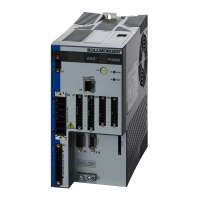20.5.3 Definition of the Used Data Types
Thischapterdefinesthedatatypes thatareused.Eachdatatypecanbedescribedby bit-sequences. Thesebit-
sequencesaregroupedinto"Octets”(bytes). Theso-called"Little–Endian”format (a.k.a.Intel format)is usedfor
numericaldatatypes(seealso:DS301 ApplicationLayer"GeneralDescription ofDataTypesandEncodingRules”).
20.5.3.1 Basic data types
Unsigned Integer
Data in the basic data type UNSIGNEDn define exclusively positive integers.
The value range is from 0 to 2
n
-1. The bit sequence b = b
0
to b
n-1
defines the value
UNSIGNEDn(b) = b
n-1
2
n-1
+ to + b
1
2
1
+ b
0
2
0
Example: the value 266 = 10Ah is transmitted in the data type UNSIGNED16, in the form of two octets (1
st
octet
= 0Ah, 2
nd
octet = 01h).
Transmission syntax for the data type UNSIGNEDn
Octet number 1. 2. 3. 4.
UNSIGNED8 b
7
to b
0
UNSIGNED16 b
7
to b
0
b
15
to b
8
UNSIGNED24 b
7
to b
0
b
15
to b
8
b
23
to b
16
UNSIGNED32 b
7
to b
0
b
15
to b
8
b
23
to b
16
b
31
to b
24
UNSIGNED40 b
7
to b
0
b
15
to b
8
b
23
to b
16
b
31
to b
24
UNSIGNED48 b
7
to b
0
b
15
to b
8
b
23
to b
16
b
31
to b
24
UNSIGNED56 b
7
to b
0
b
15
to b
8
b
23
to b
16
b
31
to b
24
UNSIGNED64 b
7
to b
0
b
15
to b
8
b
23
to b
16
b
31
to b
24
Octet number 5. 6. 7. 8.
UNSIGNED8
UNSIGNED16
UNSIGNED24
UNSIGNED32
UNSIGNED40 b
39
to b
32
UNSIGNED48 b
39
to b
32
b
47
to b
40
UNSIGNED56 b
39
to b
32
b
47
to b
40
b
55
to b
48
UNSIGNED64 b
39
to b
32
b
47
to b
40
b
55
to b
48
b
63
to b
56
AKD User Guide |
Kollmorgen | December 2010 42

